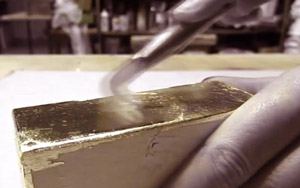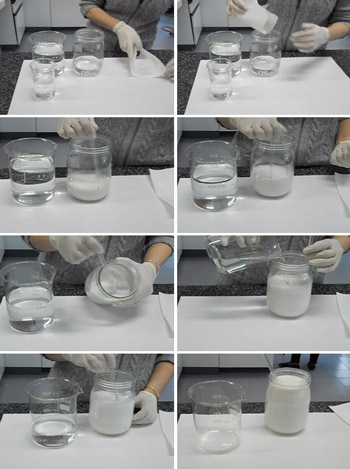YESO MATE (GESSO SOTTILE) TO CARRY THE PROCESS OF BURNISHING WATER GILDING OF ALTARPIECES
|
Description |

Example of use of yeso mate
Yeso mate has traditionally been considered as a particularly suitable material to carry out the burnishing water gilding process. However, materials currently marketed under the name "yeso mate" do not fully coincide in most cases in terms of morphology or composition with those obtained by traditional methods or those corresponding to actual work.
In the painting-restoration department of the Faculty of Fine Arts of the Complutense University of Madrid has recovered the procedure for the production of matte plaster described in artistic treatises, which refer to its development since the 14th century.
|
How does it work |

Summary of the procedure for the production of yeso mate
Yeso mate is a particularly soft plaster with which it can be a layer, an exceptionally spongy preparation to carry out the process of burnishing water gilding, a process that took place in altarpieces, in religious imagery and in frameworks.
There are artistic treatises from the fourteenth century to the twentieth century that refer to its elaboration, carried out in many cases by the gilder himself. However, in studying the morphology and composition of a large number of yesos mate currently marketed, it has been found that they do not correspond to the type of plasters traditionally used. It is proposed, therefore, to recover the traditional processing of this material.
As starting materials may be used: gypsum stone subjected to heating and grinding, plaster, or white plaster of construction; in all these cases it is partially or totally dehydrated gypsum (anhydrite or gypsum hemihydrate) or a mixture of these phases. The process is based on adding water to the starting material, allowing the material to grow, while stirring the mixture, until it no longer grows.
It is a plaster that has not forge, has not hardened, and is extremely soft, constituting an exceptionally spongy layer to carry out the process of burnishing water gilding. The gold, therefore, it is better burnished and it is obtained a greater shine for the metallic leaf.
|
Advantages |
Applying this processing method, the quality of the materials traditionally used to improve the preservation and restoration of works of art, especially altarpieces, religious imagery and frames, is recovered. The product obtained by the traditional procedure has been compared with that observed in samples of preparations corresponding to real work (samples of altarpieces) and has been found to coincide fully with its composition (calcium sulphate with two water molecules) and morphology (tabular, prismatic and acicular). This process of elaboration improves the process water gilding of altarpieces, religious imagery and frames.
|
Where has it been developed |
Sonia Santos Gómez is part of the research team on Documentation, Conservation and Restoration of Heritage, whose main researcher is Margarita San Andrés Moya. It is a Consolidated Interdisciplinary Research Group, validated in 2005 by the UCM and ANEP, and financed by the IV PRICIT UCM-Comunidad de Madrid (2006-2009) and by the Banco Santander Central Hispano-UCM (2009- 2011).
She collaborates with other research groups of the UCM (Department of Microbiology III and Department of Chemistry-Physics I) and with the Laboratory of Materials of the Institute of Cultural Heritage of Spain (IPCE) through a Research Agreement between the DGBA (Ministry of Culture) and the UCM.
His lines of research focus on:
- Artistic technology. Production and use of artistic materials throughout history
- The industry of polymers and plastic materials. Relation to the conservation of patrimonial objects
- Techniques of characterization of artistic materials
- History of conservation and restoration
- Museology and Museography. Preventive conservation
- Cleaning systems.
|
And also |
Collaboration is offered to companies dedicated to the elaboration of materials used in the artistic field, in the conservation and restoration of works of art or in construction. Especially, companies interested in the elaboration of plaster of Paris following the traditional method.
|
Contact |
|
© Office for the Transfer of Research Results – UCM |
|
PDF Download |
|
Classification |
|
Responsible Researcher |
Sonia Santos Gómez: soniasantos@art.ucm.es
Department: Painting-Restoration
Faculty: Fine Arts


